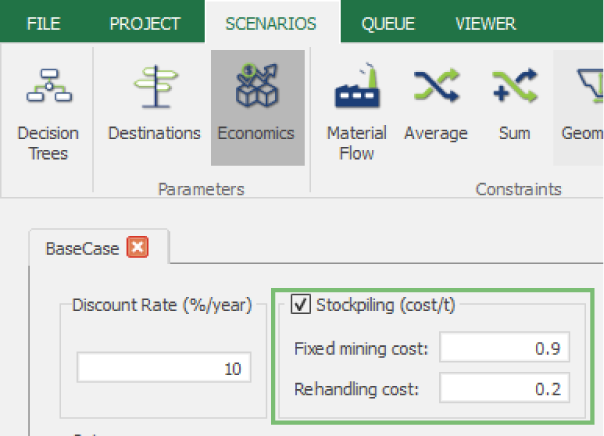Stockpiles
Highlights
Stockpiles help recover value from blocks initially marked for dumping, while smoothing production over time.
- MiningMath includes stockpiles directly in the optimization, using net value and correct discounting to decide what goes in and what comes out.
- Blocks are automatically reclaimed during shortages, reducing manual edits and speeding up scenario testing.
- Inventory and final disposal are treated separately, preventing value loss and aligning with real-world constraints.
How MiningMath handles stockpiles
Stockpiles are handled as a post-processing stage within the optimization algorithm. After generating the mining surfaces, the algorithm reviews blocks initially considered for discarding and evaluates which ones have the potential to be stored for later processing instead of being sent to the dump. In other words, this all occurs as part of the optimization process, before the final destinations of the blocks are determined.
MiningMath evaluates whether a block’s net value (Revenue – Fixed Mining Cost – Rehandling Cost) exceeds the cost of discarding it, applying the appropriate discount rates for both the extraction and processing periods. This means that stockpiles effectively optimize blocks initially destined for the dump, potentially recovering additional value. For selecting a block’s destination, MiningMath uses the same logic of maximizing project value. The software identifies which discarded blocks should be reclaimed to address production shortfalls over time, ensuring optimal resource utilization. The diagram below summarizes the stockpile methodology.
Stockpiles setup
To enable the stockpiles on the interface the first step is on the General tab where two inputs are required:
Fixed Mining Cost: value used to decompose the economic value while considering stockpiles.
This cost is essential because MiningMath uses this parameter when calculating economic values. It helps break down the block's value, allowing the algorithm to accurately account for costs incurred during mining and those applied during processing.
Rehandling Cost: represents the cost to reclaim blocks from the stockpile to the process.
This cost is applied to break the economic values into parts and apply the discount rate at the time a block is processed.

After that, on the Destinations tab, you can define stockpile limits for each processing plant added, remembering that this limit is based on the life of mine, not in a period timeframe.

Disclaimer: stockpiles and total tonnage
Since stockpiles are a post-processing unit of the algorithm, total tonnage restrictions might be violated when the stockpiles are processed. Total tonnages restrictions are only considered during the processing unit of the algorithm.
Disclaimer: inventory pile, storage and stockpile
When defining the stockpile, MiningMath’s algorithm ensures that ore blocks are not discarded and later recovered from the waste pile. Instead, ore blocks that cannot be processed immediately due to period constraints are sent to the inventory pile after sequencing. During sequencing, blocks are marked for disposal but are only discarded once storage is finalized. This process ensures that ore blocks, marked for disposal due to period constraints, are identified and stored in an inventory for future processing. This prevents blocks from being mistakenly discarded because of scenario constraints.
- Which blocks have been stocked?
- Which criteria is used for the reclamation policy?
- How to incorporate variable mining costs into the economic modeling?
- How to incorporate a pre-existing stockpile from ongoing operations?
- How to incorporate underground material into the optimization along with open-pit material?



